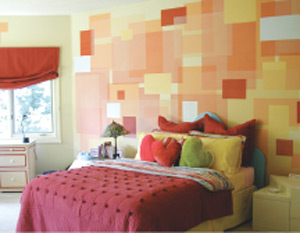
Q&A Painting a Child's Room
By on Sep 07, 2007

Q. What is the most challenging aspect in designing a paint
finish or mural for a child's room?
their child's room has to fit into the colour scheme of the rest
of their home. Or they choose colours in shades that wouldappeal to an adult sensibility. It's important to allow a kid's
room to be a kid's room! Create a space that is safe, inspiringand fun. It should be about the child and their personality.
Having said that, kids grow up at such a rapid pace thatanother challenge is to create wall finishes with longevity.
Q. What are specific ways to give the design in a child's
room longevity?
everything in the room. Theming everything, from the
lighting, bedding, drapery, framed posters and wall murals, canquickly get tiresome. Reserve the trendy items for the
decorative accents like toys, switchplates, and mirrors. Choosewall colour that will work with many of the objects in the room
including the existing bedding and furnishings. If negotiatingwith your child means using trendy or truly bright colours,
consider painting one wall as a focal point with the other wallsas paler versions of that colour or as neutrals.
Q. What advice would you give to parents who are painting
their child's room for the first time?A. Define your budget. If you want maximum impact on a
minimum budget and can paint the room yourself, try a uniquepaint finish or mural. Painting the walls of a child's room is a
great place to start since colour has such a huge emotionalimpact on us. If your child is old enough, involve them from
the start. By including them in the decision-making processthey'll feel that they've invested something, and they'll take as
much pride in their space as you will. Do give your child colouroptions but be sure to show them colour swatches that both of
you can live with. Remember that, regardless of the wall colouror finish, your children will decorate walls with their own
interests over time. But take comfort in knowing that paintinga room is still one of the most affordable and impactful ways
to update a room.

Q.What is an "activity wall" and how are they different from
a mural?A. A mural is a large image that is painted directly on a wall's
surface. They often consist of scenes such as landscapes orcharacters from popular children's books. An activity wall
incorporates objects mounted directly onto the wall on top ofa painted mural. They are interactive. Items such as magnet
boards, chalkboard paint and lighting are integrated directlyinto the mural scene and serve a dual purpose. For example, a
shelf will form part of a ladder on a fire engine mural orcolourful hooks hung up in a row within a child's reach can be
used to hang up clothing while appearing to form the bolts onthe hull of a submarine mural. Activity walls are an
imaginative and fun way to add functionality to an otherwiseflat mural. It is a great way for kids to interact in their space
and with their favourite things.
Q.What are some things to keep away from when decorating
a child's room with paint finishes?
finishes don't necessarily need to cover all the walls in a room.
A paint finish applied to one wall will often be moreimpactful than painting the whole room. Try to remember that
it's not your fantasy room but your child's fantasy room.Raggedy Ann and Andy may have been your ultimate
bedroom heroes but your child may have different ideas. Avoidtrying to incorporate every colour under the sun. Using too
many colours can be more confusing than helpful. Instead, usea child's favourite toy, clothing or beddings as the basis for
creating a palette. But don't be afraid of colour. Remember thatif you don't get it right the first time change is only a paint
can away.


